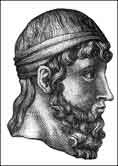Science and Aesthetics
Thanks to the so called Age of Enlightenment science and aesthetics seem to have been going
their separate ways, again a classic conflict between the left hemisphere with its thirst for accurate,
verifiable knowledge (and wish to dominate), and the right hemisphere's more ephemeral, global thirst for the
otherness (beauty, peace, integration) in life.
All that looks set to change. For
the most recent impact of science on aesthetics we must move straight into the 21st century and new
scientific evaluation of the topic. Here we find 2 varieties, the practical experiential and the practical
philosophical. In the former we find neuroaesthetics, neuroarthistory and neuroacoustics, while in the latter we
find such as Iain McGilchrist and his research into the functions of the left and right hemispheres of the brain and
their impact on our every day lives.
Recent neuroimaging studies have
identified activity in diverse brain regions in the context of aesthetic valuation of paintings, photographs,
architecture, music, and dance, but in regions which overlap, i.e. they share common pathways. Neuroaesthetics was
first developed in 2002 as the scientific study of the neural bases for the contemplation and creation of a work of
art. Professor Semir Zeki, a neurobiologist at the University College London, has discovered that the same part of
the brain which is excited when you fall for someone romantically is stimulated when you stare at great works of
beauty. Viewing art triggers a surge of the feel-good chemical, dopamine, into the orbito-frontal cortex of the
brain, resulting in feelings of intense pleasure. He also contends that there is an overlap between these parts of
the brain and those which are stimulated by cognition of virtue or morality. A notable feature of Prof. Seki's
experiments is that the same responses were achieved across the cultural divide.
Dr.
D.W. Zaidel from the Department of Psychology, UCLA, Los Angeles, working with Marcos Nadal, in an
article published in the summer edition 2011 of Perspectives in Biology and Medicine, stated that "neural
imaging studies during the last decade have revealed that moral reasoning or aesthetic appreciation rely on
activity distributed across multiple cortical and subcortical brain regions, rather than on a single especially
dedicated neural mechanism". "None of the brain regions that constitute the networks associated with
moral or aesthetic judgments are exclusively dedicated to these domains. They are all engaged in tasks related
to diverse spheres of human experience, though they seem to contribute with similar computations across all of
them. Moreover, the fact that the identified regions vary from one experiment to another, both for morals and
aesthetics, suggests that the demands of different moral tasks, such as solving moral dilemmas, viewing scenes
with moral content, reading sentences conveying guilt, or judging the permissibility of another's actions, rely
on partially overlapping subsets of the regions described above". They suggest that it is the use of
these common neural pathways which link the concepts of aesthetics and morality in the mind, and that they were
inherited from distant ancestors.
In the ever developing world of mapping the brain
Professor Onians, developer of the concept of neuroarthistory (having worked with Prof. Seki), has said
that neuroarthistory can be used "both to better understand the nature of familiar artistic phenomena such
as style, and to crack so far intractable problems such as ‘what is the origin of art?’" According to a
press release, neuroarthistory can explain why Florentine painters made more use of line and Venetian painters more
of colour. The reason is that 'neural plasticity' ensured that passive exposure to different natural and man-made
environments caused the formation of different visual preferences.
Another new
field, neuroacoustics, or neural resonance, is concerned with delving into which parts of the brain are
used for music (pulse, meter and harmony) but there is a branch concerned with using sound for healing and
meditation. In the latter the brain generates electromagnetic signals, which can be detected with EEG
(Electro-encephalogram) equipment. Different frequencies are produced depending on neural activity. Neuroacoustics,
in this case, is the feeding back of these frequencies to the brain through the use of sound waves. Using it the
perpetrators say you will be able to meditate like a Zen Buddhist monk (and one user added 'on steroids'!). This
latter use of science seems to me gain without pain, achievement without effort and to be what most in modern
society desire. One then needs to question both their need for it as well as there use of it if they are so flimsy
in their efforts to achieve the ends.
Such science is, of course, to be
welcomed, particularly neuroscience which, for the first time, seems to have positively linked aesthetics
and virtue, a process advocated by philosophers since the time of Plato. Yet it raises two issues. It presents a
mechanistic view of how the brain operates rather than why or how to produce such operations, let alone the origin
of imagination or inspiration. Second it does not contribute to the debate as to whether consciousness is separate
from brain activity, i.e. whether humanity has a controlling influence outside the brain.
From another perspective we have Dr Iain McGilchrist considers that the two hemispheres have
not only different functions but different outlooks on the world. I quote from the Scientific and Medical
Network's summary of an exposition he is to make to the Annual Meeting of this body: “Making full use of the
multi-faceted experimental research into the brain in the last two decades, he suggests that the left
hemisphere’s main aim is self-interested manipulation, and it is narrowly-focussed, yet at the same time
obsessed with theory at the expense of the unique reality. It misunderstands everything that is not explicit,
lacks empathy, construes us, our minds and bodies, as machines, and is unreasonably certain of itself. And it is
in denial about its limitations. The right hemisphere, on the other hand, while having a much broader and more
generous stance towards the world, and understanding far more than the left, lacks the necessary certainty to
counter this onslaught, since its knowledge is far more complex and less conducive to propaganda. Traditionally
the two hemispheres have worked together, but McGilchrist believes that in modern times the left hemisphere has
grabbed more than its fair share of power, resulting in a society where self-obsession, greed and plodding
rationality hold sway, at an enormous cost to human happiness and the world around us.”
If I dare to interpret this in terms of my debate on the role of spirituality it
would seem that life in terms of business, politics and the media is increasingly governed by left hemisphere
dominated people, those whose lives are governed by a time-orientated, logical, mechanistic and ordered approach to
life, who have little time or empathy for those whose lives lie outside these parameters. Here I think not only of
religion but those who are dispossessed of their homes through the debt of negative equity, made redundant through a
rationalised downsize of their employment, have no voice through the vagaries of a 'rational' approach to politics
caused by a logical but totally unholistic approach to elections, ie the first past the post system which operates
in the United Kingdom.
We live in a troubled world of ever increasing complexity
and conflict. It is hard to keep pace with change, particularly on the technological front. Mobility is
the order of the day not only in search of work but in search of solutions of what it is to be human. Yet we long
for some form of stability in our lives, particularly in our thinking, to provide a bastion, a secure respite which
enables us to cope with such change. Many, of a religious persuasion, sink into fundamentalism for this security.
Others, as evidenced by governments, some scientists, and many legal institutions resort to what is viewed as prime
manifestations of humanity - reason, evidence and logic. Both are the opposite sides of the same schizophrenic coin.
It is increasingly a common view that a scientific understanding of the universe will
provide a solution to gaining all knowledge, or so such as Richard Dawkins would have us believe. Belief
in mathematics, physics, biology and chemistry, together with their solutions, represents the highest achievements
of humanity. To which I, for one, give a resounding "yes, but" reply.
There
is no question in my mind that we have much to learn particularly from mathematics and the new neuro sciences in
the understanding of aesthetics. Similarly we stand in awe at the work of our physicists who have probed
the depth of the universe back to milliseconds after the Big Bang, the images provided by the Hubble telescope, the
construction of the atom, and the philosophy of Quantun Physics.
And yet, here in
the 21st century we see a strange coalescence of the two. There is a growing realisation in the business
world of the value of aesthetics in gaining profit. Whether one is considering web design, promotion of products,
presentation of ideas, design of buildings, aesthetics has become big business. Therein lies the problem.
Aesthetics, in its true state, is more than this. It encircles truth, virtue, morality and goodness, all of which
aspects seem to be missing from most of the business world.



